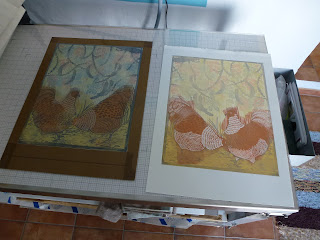 |
| inking up the first 3 colours in one go |
A lot of times, newcomers to the world of lino reductions, look at the roller like there is a little gremlin living in it, that applied too much ink (messy) or too little ink (nothing) or uneven, stripy, blotchy, yes, there are many variations of applying ink ;o)) Sorry, no gremlin, just you...... so I always talk about the internal logbook you need to keep as a printmaker, the log book you refer to, when you wonder if there is enough ink on the roller, the sound the roller makes when it is perfect, the look of the ink on the roll up board, ( it looks like finest sandpaper) and you store that way.... so that next time, you can open your log and look back and use that knowledge, that experience...... it takes a while to get used to constantly be thinking whilst you work, there are so many things to remember,
not least the darn b-ggery registration..... but try... really try... make written notes, although I find that irritating and that it breaks my rhytm, but this is about you... about you finding a way, a method of storing what you learn as you print, a conscious, thought out storing file cabinet for all the stuff that is needed when it comes to printing a 6 - 7 - 7 or maybe even 10 colour lino reduction. I know, it is easy for me to say, I do this every day (almost), and repetition of course, makes you better at it, but still, a log book...... give it a try!
 |
| the lino plate inked |
 |
| the print after the first run through the press |
tomorrow....... great strides with 4 colours in one day!! See you......




This looks like good fun!
ReplyDeleteThe idea of an "internal log" is good (though for me it also needs to be written down - even if I don't refer to it while I work, I need it there to "revise" some time or other...).
But you're right - any craft needs to be practised, to build up that knowledge base, the experience - sound, "feel", touch...even smell perhaps - that tells you when something is "right".
And it's also stuff like knowing when your ink is getting dried out (water based inks really) - so they go all stiff and yukky. And how to roll the roller, so you don't have streaks or spotty bits...
Mariann is the one to ask - she knows this stuff! And she's a good teacher too - I know this because I was her student for a week and I learned LOADS!
Thanks for this, Mariann, it's very useful.
And I love those chickens already!
Yes, all good things to know.Once you've learned!
ReplyDeleteA few years ago I was part of a lino exhibition which we called "Listen to the Ink." It says a lot.
I know what you mean when you mention 'internal log'. I write techncial notes in sketchbooks quite often but it is the combination of the sights and sounds of what' happening that count most.
ReplyDeleteIf I haven't used a technique for a while I might look up my notes to start me off, but it's the actually doing of it that snaps me back into.... yes it needs to sound like that when I'm rolling the ink.... if I mix the ink like this... etc
Great Information about printing ink. Actually I am working on INK Dispensing System
ReplyDelete